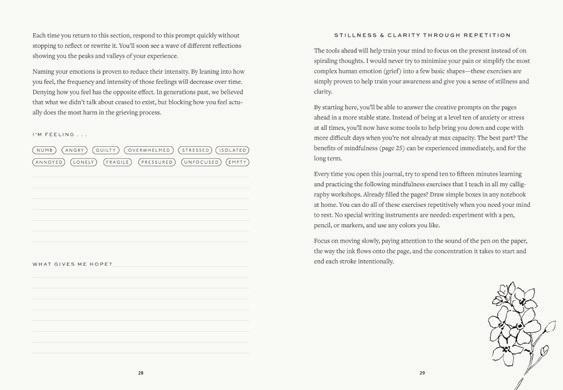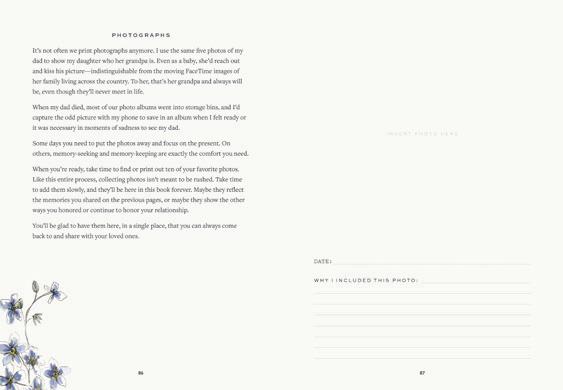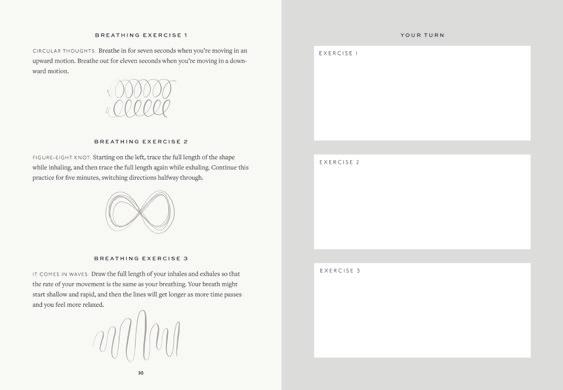




Even though I’m so glad you’re here, I wish we didn’t have to meet this way. Your loss is, was, and will always be with you. And I’ll never pretend to know the weight of your grief’s impossible load, even as I carry my own. We’re simply walking beside each other so that we feel less alone.
What we do share is a knowing. A depth of feeling that only losing someone you love exposes. A deep desire to understand and remember and commemorate our people in a forever kind of way. I’m heartbroken that you’re here and also truly honored to help you use your own words to do just that.
In the act of writing and reflecting through these creative prompts, I hope you begin to feel some semblance of relief. Whenever you open this journal, I hope it feels like a safe place. A single source for all of your best memories to go into safekeeping. An heirloom to honor your loved one’s legacy, and a place to freely share what can feel too vulnerable to outwardly express. I hope this journal helps you accept your pain, your love, and your longing and see how much these feelings change each time you sit down to write.
Because if there’s one universal truth, it’s that however you’re experiencing grief right now, it won’t be the place you stay. MY STORY
I’m an artist: a watercolor painter and calligrapher. A writer. A loving mom and wife and sister and friend and daughter who still deeply misses her dad. I always will.
When I was thirteen years old, I heard the wheels of my mom’s computer chair hurrying across the hardwood floor upstairs. Seconds later, her feet were missing stairs to get down to us.
I remember staring at her in unison with my sister, tears already streaming down her cheeks. “It’s your dad,” she managed to say as the three of us collapsed into each other. It was on that day, October 19, 2003, that my life changed forever. And it’s been every day since that I’ve missed him.
When I was pregnant with our daughter in 2021, I found that becoming a mom after losing a parent stirred up more emotion than I was prepared for. Alongside the joy and excitement of bringing life into the world was the tragedy of my dad’s death when I was just a child too. Some days I feel like he’s right here with me, and on others I still can’t catch my breath, even two decades later. It’s a constant ebb and flow of comfort and pain, of growth and then retreat. A crushing reminder of time—both that it heals, and that grief seems to follow a path of its own.
“Am I going to be an eighty-year-old woman still crying about her dad?” I once asked my therapist, desperate through sobs.
“Yes. Yes, you will,” she replied. “But it won’t always feel this gut-wrenching.”
I CREATED THIS JOURNAL BECAUSE GRIEVING SHOULDN’T BE TABOO.
We’ve all experienced—or will experience—grief. I spent too many years beating myself up for perfectly normal feelings around losing my dad. What I wish I knew then is reflected here on these pages to hopefully be a comfort to you.
Pairing creativity with grief helped me cope with my dad’s loss twenty years ago and these seemingly opposite forces continue to help me process and heal.
After he passed away suddenly, I journaled a lot. And I didn’t know the longterm effect it would have on me to acknowledge and process what I felt during that time until much later in life, when I read and understood the research behind the journaling process.

Writing helps us make sense of our catastrophic thoughts and experiences. The concentration it takes to form words and think carefully about each stroke puts us back into the present instead of being lost in thought. We don’t need to have any answers or perfect sentences or beautiful prose. We just need to slow down and put pen to paper. And in the simple act of expressing ourselves, even if those words never see the light of day, writing lightens the load.
When I fell in love with calligraphy and started my own art business much later into adulthood, I discovered that it’s a moving meditation. Painting and writing and calligraphy aren’t reserved for the artistically inclined. Creativity is inherent in all of us, and it’s especially useful as a tool for expressing what would otherwise manifest as tornadoes inside our minds.
Please know, I wouldn’t have been able to write this journal ten years ago. Maybe not even five years ago. It’s only through time and acceptance of how chaotic and messy grief can be that I’ve learned to accept it as part of me, forever.
(WRITTEN AT AGE 10)
 WRITING ALONE HAS A PROFOUND ABILITY TO HELP US HEAL.
WRITING ALONE HAS A PROFOUND ABILITY TO HELP US HEAL.


I’m no longer weighed down every hour of the day. I’m living a full and joyful and truly happy life. But the sadness and despair still come, and those feelings are still at the center of every new experience. So, when the waves wash in, I’ve learned to sit with them. To write about it so that the space those thoughts occupy in my day and brain can be released to paper. To know that, as unfair as it often feels, this is normal. This is what it means to be in grief and to miss someone you love.
In many ways, I’ve come to learn, I grieved my dad long before he died. My dad suffered from alcoholism most of his life, but it doesn’t define him. He loved us dearly, and he had his own internal battles. He died far too young, and he imparted more wisdom than he’ll ever know. He created beautiful childhood memories for my sister and me, and he succumbed to his addictions.
I always loved him, and I always will. Two things can be true at once.
YOU CAN STILL LOVE AND FEEL HURT.
YOU CAN STILL GRIEVE AND FIND HAPPINESS.
Maybe you need those reminders too.
My dad’s life and his death are the centerpieces of my life and have made me who I am. The pain of his loss changed me in ways I can only be grateful for. But the fact that I’ve grown because of my dad dying is a reality I wish I never had to face.
And so, this journal is how I’m honoring my dad, and how I hope to share a few steps in your journey too: steadfast in love, powerfully sentimental, shattered but wholly grateful for the privilege of living a wonderful life.
This is your journal to use as you need. Take what resonates and leave what doesn’t. And know that the pages that hurt too much to touch right now will be there to return to when you’re ready.
This journal isn’t a replacement for therapy, and it’s not a solution to grief. I wish it was, but there isn’t one. There isn’t a recipe for what to do when your world implodes. If there’s one thing you absolutely must do, it’s to remove the expectations you or others place on you for the time it takes to heal and how you should feel. Both are infinite. These pages are meant to help you put one foot in front of the other. To allow all your emotions to express themselves freely and not turn against yourself for feeling too much or for too long (there’s no such thing). To understand your life through loss and navigate new paths while still carrying the load.
I’ve shared some of my own stories here to encourage you in yours, because it’s through connection that we sometimes feel less alone. Let my words be merely a guide. A comfort. A jumping-off point when you’re staring at a blank page or with a mind blanketed by the numbness or crushing reality of living in grief.
And, whenever possible, give yourself some time after writing here before going back to your regular day. Grief expert and author David Kessler suggests ending a writing session by telling yourself, “That was then, this is now,” and recentering yourself back into the present. Acknowledge the room you’re in. Activate all five of your senses. And always ask for a hug.


This is a journal that you’ll want to come back to hundreds of times over the course of your life. Sometimes to reflect on passages you wrote months ago, and in others to respond to a prompt for the first time, which might have felt too raw when you last sat down to write.
I imagine that some pages will be for you and you alone, and others might be shared with friends and family when your memories become part of future moments. When writing, you might put into words for the first time what has been etched into your brain for years without realizing it. You might feel relieved to see it on paper, knowing that those stories and their wisdom are here now, whenever you need them most.
WHERE TO START
Just like life, loss isn’t linear. And so, this journal doesn’t have to be either. There’s no end goal here. This isn’t about “getting over,” “moving on,” or “forgetting” anything at all. You’re simply moving forward. One step, one page, one word at a time.
REST
I encourage you to start with the Rest section every time you sit down to write, but there is no end.
Even after you fill in the last line of this journal, you can revisit those same questions years from now and notice how you’ll write a completely different response. Similarly, flip through to see which quotes and artwork speak to your experience now, and how each new day or month will draw your attention elsewhere.
There are blank pages in the back of this journal where you can write letters to your loved ones. Use these upon receiving this journal or whenever the feeling strikes. Write to your loved ones about your intention behind putting pen to paper. Expand on some of the creative prompts ahead. Tell them about a particularly hard or surprisingly good day when they made their love known to you. And remember: don’t write to impress. We’re simply here to express.
HOW DO I KNOW IF I’M READY TO WRITE?
Whether you received this journal as a gift, it came up in your search results, or it called to you from the shelves of your favorite bookstore, you have a big heart. You’re sentimental and a bit nostalgic. Maybe you’ve never written before, but you want to honor who you lost, and you’re afraid those memories might start slipping away. You want their legacy to be the roots of your life. And it will be.
Remember: you’re not writing perfect prose. You’re just putting pen to paper.
MY GRIEF IS FRESH
If you’re holding this in your hands in the days after losing your loved one, I wish I could give you the air from my lungs instead. Grief is loud and allconsuming, and instead of commemorating you need only try to comprehend. Writing a single sentence, let alone a story about your last memory together, may feel far too exposed. I’m sure you hate hearing the phrases “Time heals,” “I’m so sorry,” and the well-meaning “How are you doing?”, because these words don’t remotely touch the depth of your despair.
Know that however you’re feeling right now, it’s valid and you’re allowed to be “too” sad. Flip through to find quotes that resonate with you and spend time within the Rest, Cope, Reflect, Learn, and Letters to You sections until you feel comfortable surfacing legacy and memories. That time will come.
I’M NAVIGATING THE YEARS AFTER LOSS
Your sadness is just as valid on day one as it is decades later. Your joy is too. And if it feels impossible for the two to coexist right now, know that’s okay, and know that they someday will. This journal is your companion: a place of safekeeping for all your memories with your loved one, and the ways their love continues through you for the rest of your life. I hope you find comfort here, especially in the Reflect section that starts on page 62.
I’M CONSIDERING MENTAL HEALTH SUPPORT OR THERAPY
I’m a huge advocate for therapy and waited way too long to attend my first counseling session. When I did finally go in my early thirties, it changed my life. Therapy is the reason I’m able to talk so freely about my experience and move past very specific blocks caused by my dad’s traumatic death and the events leading up to it. Seeking mental health services is not a weakness—it’s a strength. Read that again.
I’M IN CRISIS
Please know that you’re loved, you’re not alone, and help is available.
In the United States: To reach a trained crisis counselor for free, 24 hours a day, seven days a week, call or text 988. You can also go to 988lifeline.org or dial the current toll-free number 800-273-8255 [TALK].
In Canada: If you or someone you know is in immediate crisis, please call 1-833456-4566 toll-free (in QC: 1-866-277-3553) 24/7 or visit talksuicide.ca. Text to 45645 (4 p.m. – midnight ET). You can also visit wellnesstogether.ca for more resources and to connect one-on-one with a counselor.
BetterHelp.com is an online counseling service currently available in the United States and Canada.
While you’re writing, I hope your loved one’s love for you makes itself known whenever you need it most.
And please know that . . .
Wherever you are in your journey, you’re not alone.
Your loss was, is, and always will be with you. You can’t feel too much or for too long.

It’s better to face your pain than avoid it.
It’s worth navigating the new path ahead of you.
HOWEVER YOU’RE EXPERIENCING GRIEF RIGHT NOW, IT WON’T BE THE PLACE YOU STAY.
And as you begin to grow around it, with no rush and certainly no timeline, grief becomes quieter—a song coming on the radio, a video online, a card you found in storage with their handwriting, the smell of their laundry soap, holidays, and firsts milestones missed.

Grief begins so loudly. Loss rings in your ears and your heart, reverberating across your entire body, your entire life. It’s all-consuming and filled with sobs that leave you breathless because there is no air to breathe.
When joy and grief begin to coexist— and they will—it can feel jarring. The beauty of new views always exists in parallel to their loss. Forever part of the same formidable yet ever-changing landscape. The grief is always there but life still grows around it and how wonderful is that?


REST
What Is Mindfulness & How Can It Help Me?
Did you know that writing is a proven practice to help alleviate anxiety? Let’s learn to get creative, not to be the best or to monetize your creations, but purely for all the tangible benefits: reducing stress, lowering your heart rate, activating your visual and motor skills, and even improving sleep. All things that we desperately need more of as we navigate the depths and chronicity of grieving.
In the earlier pages, I mentioned that art and writing inadvertently helped me cope with the loss of my dad two decades ago, and still do to this day. At the time, I didn’t understand the research behind why. Beyond the benefits of processing emotions through words, I didn’t realize that writing was a mindfulness practice and that it can be cultivated whenever you need it most.
WRITING IS RESTFUL PHYSICALLY AND EMOTIONALLY.
And although it might seem counterintuitive, it can be a much better choice than mindless activities like TV and social media that numb us instead of creating space for our feelings. (Although, we all need to strike a balance.)
Especially in the early days of grieving, doing activities that make us feel safe and contained is a lifeline. By expressing yourself in this journal, you’re less likely to be at a peak level of stress the next time another emotional storm comes. These tools will help you get back to a better baseline.





